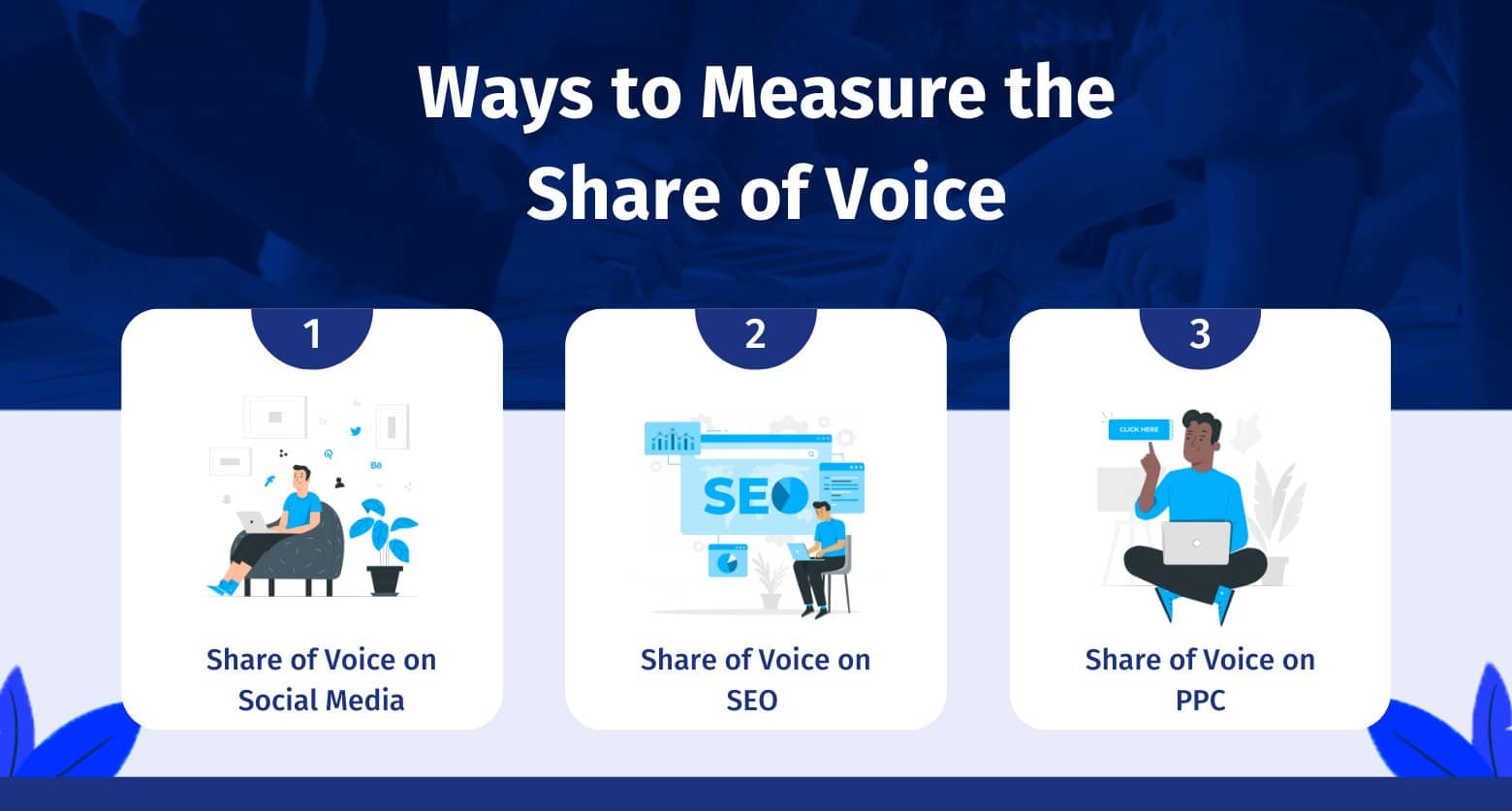
Every marketer needs to be familiar with the concept of share of voice. But what exactly does it mean? It refers to the market share that your brand currently holds. In the pre-digital era, this meant how much of a market’s advertising your brand dominated.
One of the most crucial marketing indicators is the share of voice (SOV). You can use it to assess your brand’s visibility compared to your rivals—the more authority inside your industry, the higher your SOV.
The concept of “share of voice” has changed in the digital age to encompass everything from digital PR to digital advertising, social media mentions, and website traffic. In other words, every measurable form of brand awareness in your specific market, whether that’s an industry or a geographic area.
This blog will explain “share of voice” and how it’s measured. Let’s start now!
Share of Voice, often called SOV, is a way to see how much attention your brand is getting compared to your competitors. It tells you how visible or “loud” your brand is in a specific space, like social media, online ads, or search engines.
For example, you’re at a big market, and everyone is talking about different brands. If people mention your brand 2 out of every 10 times, that means your Share of Voice is 20%. The higher the number, the more people are noticing and talking about you.
Share of Voice isn’t just about one thing. You can look at it in different areas, like
- How often does your brand show up in online searches?
- How many clicks do your ads get, or
- How much is your brand mentioned in news articles or on social media?
Share of Voice helps you understand how well your brand stands out in a crowded space. And the more visible you are, the better your chances of attracting new customers.
Measuring Share of Voice (SOV) is a smart way to see how much attention your brand is getting compared to others. It’s like checking how loud your voice is in a room full of people talking. Here’s why it’s helpful:
1. Shows Where You Stand
By tracking your SOV, you can see how your brand compares to your competitors. Are people talking about you more or less? This gives you a clear idea of your market position.
2. Helps You Improve Your Marketing
If your SOV is low, it might mean your marketing isn’t reaching enough people. Knowing this lets you adjust your strategy—maybe post more on social media, run better ads, or create stronger content.
3. Tracks Your Growth
As you work on your marketing efforts, measuring SOV over time shows whether you’re getting more attention. It’s a great way to track progress and see what’s working.
4. Highlights Brand Awareness
A higher SOV often means more people know about your brand. That’s important for building trust, staying top-of-mind, and winning more customers.
5. Helps with Planning
By seeing which channels give you the most visibility (like social media or search), you can decide where to focus your time and budget for the best results.
Measuring Share of Voice isn’t just about counting how many times your brand is mentioned—it’s about understanding where and how your brand stands out in the market. Since visibility can come from different places, like social media, search engines, ads, or media coverage, there are several ways to track it. Let’s take a look at some of the most effective ways to measure your brand’s Share of Voice across various channels.

Share of Voice on Social Media
Social media has become an effective medium for customers to be heard and seen. Anyone can publish content, express opinions, and interact directly with brands. Around the world, there are 4.65 billion social media users, or more than one in every two people.
Marketers must pay attention to the daily dialogue on social media platforms. Discover how your brand is being discussed on social media. Metrics like hashtags, mentions, post reach, and consumer sentiment are all trackable.
Utilize a share of voice tool specifically designed to track these metrics at scale, such as calculators.
Share of Voice on SEO
SEO, or search engine optimization, is crucial for assisting users in finding your website through natural search results. The higher you rank organically, the more “free” website traffic comes. You don’t need to pay to appear in search results because organic indicates that it occurs spontaneously.
It would be best to compare how frequently you and your competitors show up on search engine results pages (SERPs) to calculate your SOV in organic search. Both clicks and impressions can be used to quantify this.
Additionally, you may see which organic keywords you outrank your rivals for. Your chances of showing up in your audience’s search results increase as you rank for more keywords.
Your backlink profile should also be monitored. A backlink is a link that leads to your website from a different website. Because it resembles a seal of approval from the publisher, backlinks are signs of authority.
Share of Voice on PPC
Organic search is the antithesis of pay-per-click (PPC) advertising. PPC allows you to buy exposure to your desired demographic. When you run a paid search campaign, your ad will typically appear before the organic results at the top of the SERP.
To determine your SOV for a PPC campaign, select a relevant measure (such as impressions), divide it by the industry average, and multiply the result by 100.
Finding your PPC share of voice is simple with Google Ads. Go to your account, then click Modify under Campaigns. To compare yourself to competitors, select “competitor metrics” and tick the boxes next to each. Apply the modifications and start tracking your impression statistics.
You may use your PPC keywords, clicks, and revenue as analytics, just like with organic search. Knowing your SOV can help you plan your advertising budget and gauge the success of each campaign when you invest money in it.
Calculating Share of Voice (SOV) helps you understand how much attention your brand is getting compared to others in your industry. To figure it out, take your brand’s performance, like mentions, clicks, or impressions, and divide it by the total performance of all brands in your space. Then, multiply by 100 to get the percentage.
For example, if you’re tracking social media mentions, you would compare your brand’s mentions to the total mentions of all competitors combined.
The basic formula looks like this:

You don’t need to do this manually anymore. Many tools are available that can measure your brand’s visibility across different platforms.
SOV can be applied to multiple areas, including:
- Public relations coverage (PR SOV)
- Paid ads (PPC SOV)
- Search rankings (SEO SOV)
- Social media activity
Each channel gives you a different view of how your brand stacks up in the market.
Conclusion
“Share of voice” is now a much more complicated and lucrative metric. By calculating SOV for all facets of your digital marketing plan and further segmenting it based on data analytics, you obtain more than just a starting point for business strategy.
You thoroughly analyze how things are now with your business and the market. The decisions you make regarding your products and marketing can then be supported by the insights you find. Furthermore, monitoring the changes in your share of the voice over time will show how these choices have affected things.
With tools like QuestionPro, tracking and analyzing your Share of Voice becomes even easier. It offers advanced analytics, real-time data collection, and competitive benchmarking features that help you understand your brand’s position clearly. Whether it’s social media mentions, customer feedback, or market research, QuestionPro gives you the insights needed to make smarter decisions and grow your brand visibility.
For assistance with your research, get in touch with the QuestionPro team of professionals. You can use QuestionPro to get the most out of your data and receive guidance.
Frequently Asked Questions (FAQs)
Answer: An SOV of 100% means your brand has full visibility in that channel during the period measured, usually because there’s little to no competition or you’re the sole player in that niche. It’s rare in competitive markets.
Answer: In platforms like Google Ads, PPC SOV is shown as Impression Share—the percentage of potential ad impressions you received. You track this in the Ads dashboard.
Yes, by counting mentions over a set time span for your brand versus competitors. Use basic social listening tools or even manual counts to calculate your share.
Answer: Track it regularly, monthly or quarterly, to monitor trends, campaign effects, and industry shifts. Most social listening tools allow you to set up automated, ongoing monitoring.
Answer: Yes! Even if you don’t have a big budget, focusing on niche markets, creating great content, and being active on social media can help you stand out. Small brands can win by being more personal, consistent, and engaging than larger competitors.







